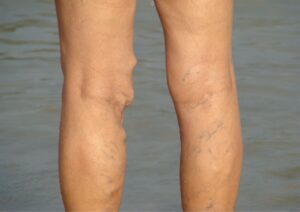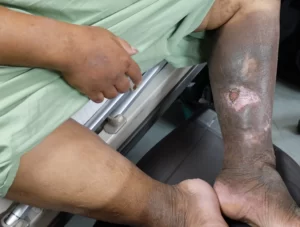Reticular veins, also known as feeder veins, are smaller veins that lie just beneath the surface of the skin. These veins, often blue or green in color, are sometimes referred to as blue veins and can appear as thin lines or clusters of small veins. They are typically larger than spider veins but smaller than varicose veins. Reticular veins are often interconnected with larger veins and can signal underlying venous insufficiency.
What Causes Reticular Veins?
Reticular veins are commonly associated with varicose veins and spider veins. They develop when the valves in the veins become weak or damaged, leading to blood pooling in the veins. This pooling causes the veins to become enlarged and dilated, contributing to the formation of reticular veins. Reticular veins are often associated with chronic venous insufficiency (CVI). Other venous issues, such as varicose veins and spider veins, often accompany reticular veins.
Untreated venous insufficiency can lead to complications such as blood clots.
What is the difference between normal veins and reticular veins?
Normal veins are not prominently visible through the skin and maintain a consistent diameter. They do not form clusters or networks on the skin surface. Reticular veins, on the other hand, are more visible beneath the skin and are often blue or green in color and appear as thin lines or clusters. They are larger and more dilated than normal veins but smaller than varicose veins.
Normal veins function properly, carrying deoxygenated blood from tissues back to the heart. However, reticular veins are indicative of venous insufficiency, where the valves in the veins are weak or damaged, leading to blood pooling and enlarged veins. This compromised function can lead to further venous issues.
Normal veins do not cause symptoms or discomfort and are a sign of healthy circulatory function. Reticular veins, located just below the skin’s surface and often referred to as superficial veins, can be associated with other venous disorders such as varicose veins and spider veins and may indicate a predisposition to more severe conditions if left untreated.
Treatment for normal veins is typically not necessary, while reticular veins often require treatment to prevent progression and alleviate symptoms. Lifestyle changes, such as wearing compression stockings, elevating the legs, and regular exercise, can help manage symptoms.
The link Between Reticular Veins and Spider veins
Reticular and spider veins are two common vein issues with underlying causes, primarily venous insufficiency. Reticular veins are larger than spider veins and appear as thin lines or clusters beneath the skin. They are found on the thighs, calves, and ankles, while spider veins are smaller and more superficial, appearing as red, blue, or purple lines. Both veins develop due to weakening or damaged valves, causing blood to pool in them, enlarge, and become more visible. Genetics, hormonal changes, prolonged standing or sitting, and age all contribute to vein development. Symptoms of reticular veins include aching, itching, throbbing, and a feeling of heaviness in the legs, as well as swelling and discomfort. Spider veins, on the other hand, are typically cosmetic concerns and may cause mild discomfort or itching. Reticular veins, also called feeder veins, often serve as a source of excess blood for spider veins, contributing to their development and visibility. Addressing reticular veins can help reduce the appearance and development of spider veins.
Symptoms of Reticular Veins
Symptoms of reticular veins may include:
– Swelling
– Itching
– Pain
– Aching
– Throbbing
– Cramping
– A feeling of heaviness in the legs
In some cases, reticular veins can lead to skin discoloration, ulceration, or the formation of sores on the legs. These symptoms can significantly impact the quality of life and indicate the need for medical intervention.
Why Treat Reticular Veins?
Seeking treatment for reticular veins is crucial to prevent the progression of venous disease and potential complications. Untreated reticular veins can lead to more severe vein disorders. Early treatment can help alleviate discomfort, improve the appearance of the legs, and prevent further venous issues.
Treatment Options for Reticular Veins
Several treatment options are available for reticular veins, including reticular vein treatment.
Sclerotherapy is a common and effective reticular vein treatment.
1. Sclerotherapy:
– This involves injecting a solution into the vein, causing it to collapse and fade away.
2. Laser Therapy:
– Uses laser light to target and destroy the affected vein.
3. Ambulatory Phlebectomy:
– A minimally-invasive procedure where small incisions are made to remove the affected veins.
In some cases, a combination of treatments may be recommended to effectively address reticular veins. It’s important to consult with a vascular surgeon or dermatologist to determine the best course of action based on the severity of the condition.
Conclusion
Reticular veins are a common yet unsightly issue that can be effectively treated with a variety of minimally-invasive procedures. Addressing reticular veins promptly can alleviate discomfort, enhance the appearance of your legs, and prevent the progression of venous disease. By consulting with a healthcare professional and considering both medical treatments and lifestyle changes, you can manage reticular veins and improve your vascular health.










